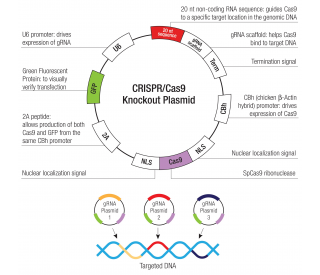Species Reactivity
Feline
Specificity
Detects feline IL-5 in direct ELISAs and Western blots. In direct ELISAs, approximately 80% cross-reactivity with recombinant bovine IL-5 and recombinant equine IL-5 is observed, approximately 50% cross-reactivity with recombinant porcine IL-5 and recombinant canine IL-5 is observed, approximately 10% cross-reactivity with recombininat human IL-5 is observed, and less than 1% cross-reactivity with recombinant rat IL-5, recombinant mouse IL-5, and recombinant rhesus monkey IL-5 is observed.
Source
Polyclonal Goat IgG
Purification
Antigen Affinity-purified
Immunogen
Mouse myeloma cell line NS0-derived recombinant feline IL-5
Ile20-Ser134
Accession # O77515Formulation
Lyophilized from a 0.2 μm filtered solution in PBS with Trehalose. *Small pack size (SP) is supplied as a 0.2 µm filtered solution in PBS.
Endotoxin Level
<0.10 EU per 1 μg of the antibody by the LAL method.
Label
Unconjugated
Applications
Recommended
ConcentrationSample
Western Blot
0.1 µg/mL
Recombinant Feline IL‑5 (Catalog # )
Immunocytochemistry
5-15 µg/mL
Immersion fixed feline peripheral blood mononuclear cells
Neutralization
Measured by its ability to neutralize IL‑5-induced proliferation in the TF‑1 human erythroleukemic cell line. Kitamura, T. et al. (1989) J. Cell Physiol. 140:323. The Neutralization Dose (ND 50) is typically 0.5-2.0 µg/mL in the presence of 30 ng/mL Recombinant Feline IL‑5.
Please Note: Optimal dilutions should be determined by each laboratory for each application. are available in the Technical Information section on our website.
Data Examples
Neutralization | Cell Proliferation Induced by IL‑5 and Neutralization by Feline IL‑5 Antibody. Recombinant Feline IL‑5 (Catalog # ) stimulates proliferation in the TF‑1 human erythroleukemic cell line in a dose-dependent manner (orange line). Proliferation elicited by Recombinant Feline IL‑5 (30 ng/mL) is neutralized (green line) by increasing concentrations of Goat Anti-Feline IL‑5 Antigen Affinity-purified Polyclonal Antibody (Catalog # AF1795). The ND50 is typically 0.5-2.0 µg/mL. |
Preparation and Storage
Reconstitution
Reconstitute at 0.2 mg/mL in sterile PBS.
Shipping
The product is shipped at ambient temperature. Upon receipt, store it immediately at the temperature recommended below. *Small pack size (SP) is shipped with polar packs. Upon receipt, store it immediately at -20 to -70 °C
Stability & Storage
Use a manual defrost freezer and avoid repeated freeze-thaw cycles.
12 months from date of receipt, -20 to -70 °C as supplied.
1 month, 2 to 8 °C under sterile conditions after reconstitution.
6 months, -20 to -70 °C under sterile conditions after reconstitution.
Background: IL-5
Interleukin 5 (IL-5) is a T cell-derived factor that promotes the proliferation, differentiation and activation of eosinophils. In mice, IL-5 is also a growth and differentiation factor for B cells (1‑3). Various names previously used to describe IL-5 include: T cell replacing factor (TRF), B cell growth factor II (BCGFII), B cell differentiation factor μ (BCDF μ), eosinophil differentiation factor (EDF) and eosinophil colony-stimulating factor (Eo-CSF). Biologically active IL-5 is a disulfide-linked homodimer. As in human IL-5, the cDNA for cat IL-5 encodes a precursor protein with signal peptide that is cleaved to generate the secreted mature protein containing 115 amino acid (aa) residues. Feline IL-5 shares 70% and 59% aa sequence identity with human and mouse IL-5, respectively. IL-5 exerts its activity on target cells by binding to specific cell surface receptor complexes. The functional high-affinity receptor complex for IL-5 is composed of a ligand-binding alpha subunit that is specific for IL-5, and a non ligand-binding common beta subunit that is required for signal transduction. The common beta subunit is shared with the high-affinity receptor complexes for IL-3 and GM-CSF. In human, IL-5 R alpha subunit is primarily expressed on eosinophils and basophils. During eosinophil development, IL-5 up‑regulates the expression of IL-5 R alpha. In contrast, in mature eosinophils, the expression of IL-5 R alpha mRNA is down-regulated by IL-5, as well as by IL-3 and GM-CSF. Furthermore, IL-5 also down-modulates cell surface IL-5 R alpha via a proteinase-mediated process that releases the soluble IL-5 R alpha extracellular domain (4‑6).
References:
Karlen, S. et al. (1998) Int. Rev. Immunol. 16:227.
Lalani, T. et al. (1999) Ann. Allergy Asthma Immunol. 82:317.
Takatsu, K. (1998) Cytokine Growth Factor Rev. 9:25.
Gregory, B. et al. (2003) J. Immunol. 170:5359.
Hellman, C. et al. (2003) Clin. Exp. Immunol. 131:75.
Liu, L.Y. et al. (2002) J. Immunol. 169:6459.
Long Name:
Interleukin 5
Entrez Gene IDs:
3567 (Human); 16191 (Mouse); 24497 (Rat); 397409 (Porcine); 280825 (Bovine); 403790 (Canine); 493803 (Feline)
Alternate Names:
BCDF mu; B-cell differentiation factor I; BCGFII; EDF; Eo-CSF; Eosinophil differentiation factor; IL5; IL-5; IL-5T-cell replacing factor; interleukin 5 (colony-stimulating factor, eosinophil); interleukin-5; TRF; TRFB cell differentiation factor I










